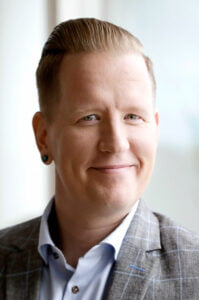Finland needs extra hands from around the world – immigration is an investment in the future
As skilled technology workers retire, new talent is needed to ensure the industry’s future. Finland’s own population is not enough, and the country must turn to workers from the rest of the world.
The technology industry is a major employer of some 330,000 people in total in Finland. However, around 8,000 people retire from the industry each year. The industry is looking on with interest and concern how and where replacement talent will be found.
“Despite the current slump in the economy, our sights are set on long-term needs. We are just starting a new survey on future talent needs, but a similar report from three years ago showed that over the next decade, Finland will need about 130,000 new skilled workers,” says Eero Manninen.

Manninen is a Senior Advisor at Technology Industries of Finland responsible for competence and work-based immigration.
According to estimates, 60% of the need for skilled workers is for tasks requiring a higher education degree and 40% for tasks requiring vocational education. In the future, demand for workers in design and product development with a higher education degree will increase, but workers in manufacturing jobs need not be concerned.
“Manufacturing jobs are unlikely to end or decrease drastically in Finland in the coming years. Professional skills and education are absolutely needed,” Manninen says.
Growing technology sectors include the semiconductor, ICT, electronics and electrical industries, among others. By 2035, the semiconductor industry, for example, is estimated to need more than 1,700 new employees with a doctorate degree. The green transition is another constant source of new need for talented workers.
ATTRACTING YOUNG PEOPLE TO THE INDUSTRY
The technology industry is putting in a lot of effort to encourage young people to pursue studies in the industry. This work is producing results, although slowly.
In the higher education joint application system, the numbers of applications to technology industries have remained relatively stable.
“Vocational education is essential to preventing necessary skills from disappearing from Finland. Effective pathways also need to be ensured for those who wish to continue their studies in higher education.”
Manufacturing jobs are unlikely to end or decrease drastically in Finland in the coming years.
The mytech.fi website by the Technology Industries of Finland shares information and advertises the sector to young people with videos and social media campaigns. Teachers and guidance counsellors can use the material with lower and upper secondary school students.
Manninen would also like to see more women in the technology sector. According to the Nuorten tulevaisuusraportti report on young people’s outlook for the future by Junior Achievement Finland, fewer than one in ten girls would consider working in the sector.
“The industry is still very male-dominated. The need for talented workers is enormous, and the industry would benefit from many more women.”
A SHORTAGE OF FINNISH TALENT
Professionals are needed, but other industries are also affected by labour shortages. The competition for employees is fierce. According to Manninen, it is clear that Finland alone is not enough to supply the workforce needed by the sector. That’s why Technology Industries of Finland has been a long-time advocate of work-based immigration.
“We need the kind of society and processes that allow people to move here to work, study or start a business and integrate smoothly into Finnish society.”
Technology Industries of Finland has calculated that in order to prevent the dependency ratio of the population from becoming too high, net immigration should be at a level of around 50,000 people each year. A similar figure of an annual net immigration of 44,000 people is also given by ETLA Economic Research.
Immigration must absolutely be seen as an investment for Finland.
According to Statistics Finland, the year 2023 was record-breaking, with a net immigration of around 58,000 people.
“This is a positive thing, even though much of it had to do with the war in Ukraine. Immigration must absolutely be seen as an investment for Finland.”
At the moment, however, the government, especially at the behest of the Finns Party, makes it harder to move to Finland for work. For example, a proposed law would shorten the time allowed to be used for job search in Finland to three months.
“We are concerned about the impact this has on Finland’s attractiveness and ability to hold on to skilled workers. The effects of these types of measures should be assessed carefully in advance to avoid actions that could negatively impact Finland’s attractiveness.”
HIGH DEMAND FOR SKILLED WORKERS
Skilled professionals are found all over the world, and Finnish companies recruit talent wherever they find it. According to Manninen, the processes for work-based immigration are relatively smooth in Finland and should be kept that way.
“The best talents can pick and choose between countries when considering where to move. That’s why we need to have effective support for integration and services for the whole family.”
Member companies of Technology Industries of Finland have also been worried what might happen if, for example, the three-month rule is passed into law under the proposed model.
“Hopefully, there is still time in the legislative process to stop and consider the consequences. After all, Finland is a relatively small country on the periphery of Europe, and reputational issues such as this travel fast and wide in the networks of skilled workers,” Eero Manninen says.
“In order to maintain something that even resembles our current welfare society, an ageing society like Finland has no choice but to become more diverse.”
WORK FOR THOSE COMING TO FINLAND
• Technology companies employ around 330,000 people in Finland directly and 720,000 indirectly.
• The share of international employees has grown in recent years, especially in the electronics, electrical and IT industries.
• In 2023, a total of 16,999 work-based residence permit applications were submitted in Finland. The number fell by 19% from the previous year.
• Between January and February 2024, a total of 2,733 work-based residence permit applications were submitted. The number of applications to be received during the entire year is estimated at 19,000. In 2025, the number of applications is estimated at 20,500.
Sources: Technology Industries of Finland and the Finnish Immigration Service Migri




